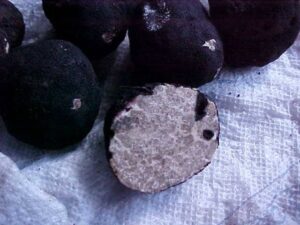Carthusianum

Scientific Name
Leucangium carthusianum
Common Names
Oregon black truffle
Seasons
Year round but mostly November – April
Description
Typically 28 – 60 g dark brown, almost black, sometimes very roughened peridium. This truffle has a thin, fragile skin, sometimes with very small diamond shaped points or warts and care must be taken not to damage the truffle in handling. In cross section the gleba (“flesh”) is marbled with dark chambers surrounded by pale, whitish veins. A ripe Oregon black truffle should have a marbled bubble like interior with mostly dark patches in shades of grey with white webbing.
Care should be taken with shipping as shelf life tends to be shorter than for other truffle species.
Aroma/Flavor
Milder than the Oregon white truffle (Tuber oregonense) they have a pronounced, fragrant aroma reminiscent of sweet pineapple, floral notes, chocolate, or cheese.
Distribution
Found only in the wild of the the Pacific Northwest region of North America (northern California into British Columbia). Dog harvested truffles tend to be of better quality as the dog tend to identify mature truffles. Raking is incriminatory and often results in unreliable crop quality.
See grading guidelines
Other species
- Tuber aestivum (black summer truffle)
- Tubber Borchii (bianchetto)
- Tuber Brumale (Muscato truffle)
- Kalapuya Brunea (Oregon brown truffle)
- Leucangium carthusianum (Oregon black truffle)
- Tuber canaliculatum (Appalachian truffle)
- Tuber gibbosum (Oregon white truffle)
- Tuber lyonii (pecan truffle)
- Tuber macrosporum (smooth black truffle)
- Tuber magnatum (white truffle)
- Tuber melanosporum (Perigord truffle)
- Tuber oregonese (Oregon white truffle)
- Tuber uncinatum (Burgundy truffle)

